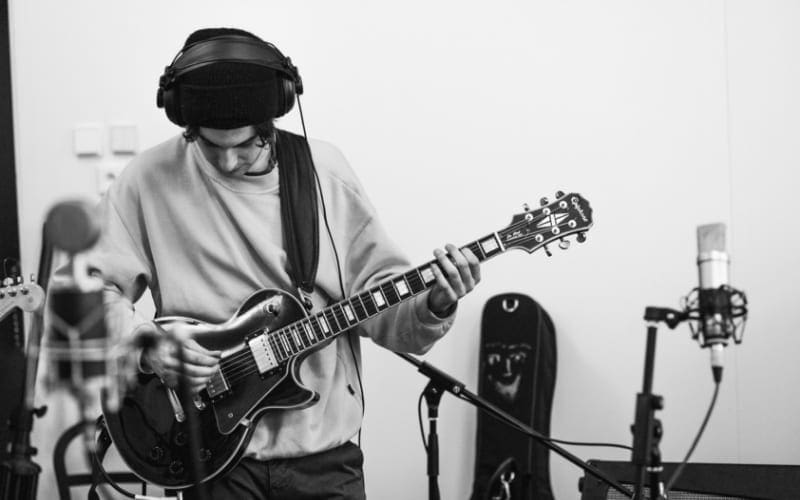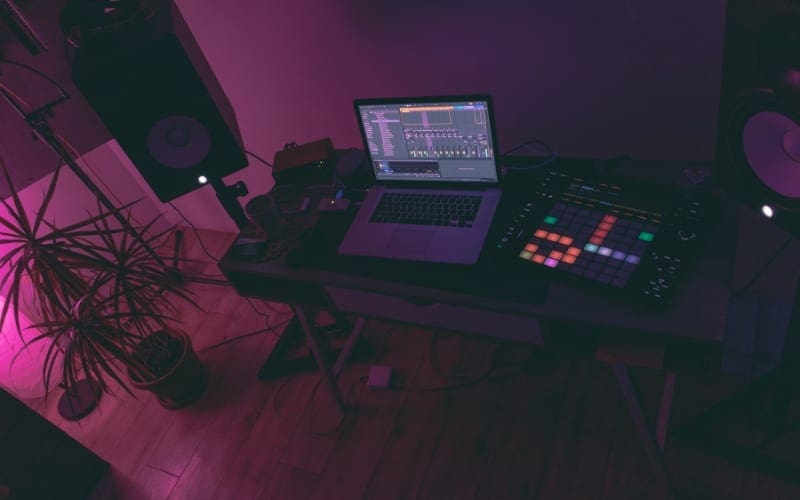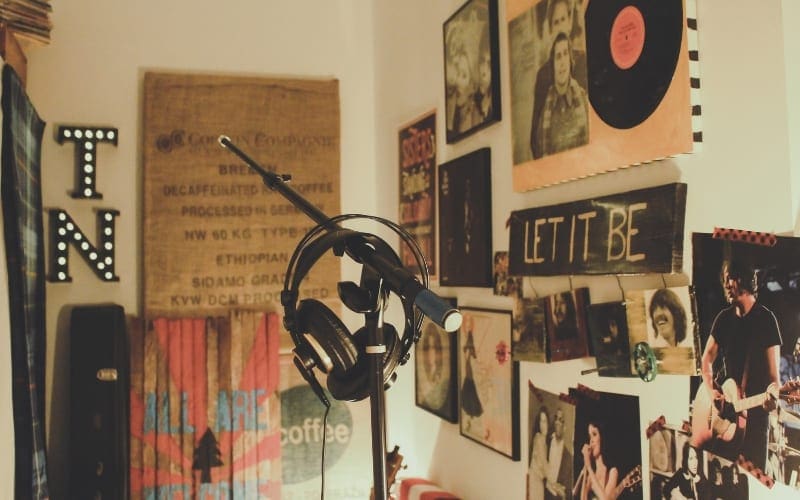If you are a musician, you’ve probably heard mention of the peculiar techie-phrase… ‘audio interface’. This article will guide you through everything from what an audio interface is, and which ones to buy (including key brands like Focusrite and Behringer), as well as some tips on free audio interface software you can get and how you can get the most out of your hardware.
Keep reading to learn all this and more!
In an industry where lines have become blurred, which used to be a performing art has now become a huge melting pot of various industry roles. We live in a modern world where the creator can be required to put on a music producer’s hat, which is often the same as a studio engineer’s hat.
This basically means your job doesn’t just end with your actual performance in the studio. You need to know how to get your microphone inputs, (mics and instrumentals), guitar, keyboard or other sounds working with your audio interface and recording software.
A home recording set-up is all you need to get your music career into serious motion, especially when you don’t have a budget to hire the services of a professional studio just yet. I know how frustrating it can be if you are a musician without any actual professionally recorded music to showcase.
Especially when there are many streaming outlets and digital stores with so much new music being released daily.
In this article, I am going to take you on an informative trip into the world of the best professional audio interface so you can better understand and choose which one is right for you, depending on your recording needs. Think of the device as an oven in your home studio.
So, What Is An Audio Interface?

An audio interface is often called a sound card and it also sends a headphone output signal to any connected headphones or speakers, allowing you to monitor your sonic creation in real-time.
It’s a physical hardware product that allows your musical input to be converted into a format (language/software) your computer understands. You can then do all your music production and mixing within your recording software package aka DAW (Digital Audio Workstation) such as Pro Tools First, Mainstage 3, Cubase, Logic Pro X, Reaper or Ableton. There are also free online beat makers to consider if you want to get up and running for gratis.
Many devices in the market have great recording software options these days but I recommend going with one of these more popular ones to make studio collaboration easier in future. There are even free recording studio software options available!
Also look into what studio equipment and studio recording software other musicians in your genre tend to use, as that can be a big factor with VST plugins, desired use and functionality etc.
It’s the gear that allows you to input your raw music performance and end up with a finished, ‘baked to perfection’ end product to serve your fans. If you are just a singer-songwriter recording a keyboard or guitar and vocals, you won’t need a big oven to cook up your intimate sonic offerings.
If you are a band or you work with more than a couple of line inputs at a time, you will need a bigger, more advanced oven. Depending on your choice you also want to double-check that it is compatible with your software; your current DAW and your computer OS before you buy.
Professional Level Sound Quality

The good news is that once you find a suitable audio interface and suitable software, it will give you the ability to produce music, good-quality music that will hold up against other professional artists in the game. Most available brands today have great sound quality. It’s important, however, to also capture a great performance, and that is on you!
The advantage of a home recording set-up means you have the freedom to keep trying until you’re happy with your performance. This is often not the case in a more pressured and paid-for studio environment.
Once you’ve captured your beautiful performance, take care to get your music mixed and mastered by a professional if you are shaky in that department. It is affordable to do so and can be the make or break of your home studio investment paying off sooner rather than later.
So let’s dive in and see which calibre of hardware is right for you and what factors you need to consider in order to make a good decision…
What should you already have set up?

Make sure to check out the pro-tip at the bottom of the page that may save you extra money if you are still gathering your studio elements together.)
Before you look at making a purchase, you need to be equipped to use it.
The basic set-up needed includes a good computer that is capable of running your DAW with low latency. That takes care of your processing and editing.
You then also need your instrument cables and/or a condenser microphone to plug into your interface or use a microphone preamp or mic preamp if desired.
Finally, you need your studio monitors. These are studio-designed speakers for you to listen back to your recording as you work. Monitoring headphones are also a popular initial choice for travelling musicians and producers, or if you need to work quietly.
What are you going to be recording?

This is an important question to answer so you can select an interface that is going to allow you to record with no surprises down the road, such as not having enough mic inputs to record at the same time, or not having the right kind of inputs or outputs to plug into.
For example, as a singer-songwriter, I am usually recording up to two things at a time, so I need at least two inputs. One for my microphone and one for my instrument; usually a guitar. Interfaces should be able to receive an extra USB signal (via your computer) or have their own extra midi connection for a keyboard anyway.
I currently use the Focusrite Scarlett 2i4 interface which has two XLR combo inputs that can each also take a jack input from my instrument. The unit also has a midi input at the back for me to send a midi signal from my keyboard.
This can come in very handy if you ever run out of USB ports on your computer and have a midi output available on your keyboard. The 2i4 also has RCA outputs for anyone needing to plug into DJ equipment, which leads me into…
Interface Connections
This is the equivalent of checking what type of power socket you have in your kitchen before you buy your new digital sonic oven of choice. Check what connection your computer has for an audio interface. Currently, the main options are:
- USB – The popular choice for commonality and USB allows you to power the interface without needing an external power source, which is great for portability
- Thunderbolt – Super fast connection and is becoming the new industry standard but is not necessary if you are planning to record only a few channels
- Firewire – Not as common a connection on computers but you can install a Firewire Card on your PC
- PCIe – Also not as common for home studios and they need to be installed internally to your computer’s motherboard

I/O Channels
This is one of the main factors to consider before you buy. How many Input and Output (I/O) channels do you require? An input channel is one signal going into your program, usually either a microphone or an instrument. An output channel is a signal going out to a speaker or an external device. If you need to record four things at once, then you’ll need at least four inputs that can each take whichever type of connection is required.
Phantom Power and Hi-Z
Phantom power is a feature your interface needs to have if you are using a condenser microphone which won’t work unless it is powered. Hi-Z is a feature that allows for hi-impedance instruments like guitars to be connected with the best audio.
Bit Depth and Sample Rates
These two specs deal with your audio resolution, so to keep up with industry standards, I recommend choosing an interface that records at a 24bit depth with a sample rate of up to 192kHz, even though 16bit audio and a 44.1kHz sample rate are still in use today. Each interface should have these specs visibly available. Think of this as how many megapixels a camera would have in order to capture a high quality image. The same applies to the sound quality of your master recording. In this case, the higher bit depth (24bit) and sample rate (192kHz) are preferred.
These two specs deal with your audio resolution, so to keep up with industry standards, I recommend choosing an interface that records at a 24bit depth with a sample rate of up to 192kHz, even though 16bit audio and a 44.1kHz sample rate are still in use today.
Each interface should have these specs visibly available. Think of this as how many megapixels a camera would have in order to capture a high-quality image. The same applies to the sound quality of your master recording. In this case, the higher bit depth (24bit) and sample rate (192kHz) are preferred.
What Will It Cost You?
More good news is that you can get an audio interface for cheap! Entry-level interfaces sell for as little as 42 dollars and they deliver great sound quality. You can also get some great software (for free).
On top of that, most of these are on Amazon for sale. Let’s have a look at what audio interfaces are for sale!
Audio Interfaces worth reviewing from low to high priced order
1. Behringer U-Phoria UMC22 USB Audio Interface

- Inputs: 2
- Outputs: 2
- Phantom Power: Yes
- Audio Resolution: 16bit/48kHz
- Connection: USB
- Midi In and Out: No
Price Range: $59 and going for as low as $42 at the time of writing.
U-Phoria UMC22 Behringer Audio Interface Review: This budget unit saves costs due to its plastic housing, making it not the most portable interface and it doesn’t have 96kHz capability or higher.
Delivering surprisingly good quality audio for its price, making it adequate to get you moving if your budget is limited. Another bonus is that the headphone jack signal is exceptionally strong too.
However, this is not the only interface Behringer offers. This is the slightly bigger, slightly better version of the Behringer audio interface UM2.
2. Native Instruments Komplete Audio 2

- Inputs: 2
- Outputs: 2
- Phantom Power: Yes
- Audio Resolution: 24bit/192kHz
- Connection: USB
- Midi In and Out: No
Price Range: $139
Notes: For a little more money, you’re getting a better, sturdier interface that also has a higher 24bit/192kHz capacity. This is a more recommended entry-level purchase if you are serious about taking your music to greater heights.
This unit still has no midi recording capability, however, if that’s something you need within your studio setup.
3. Focusrite Scarlett 4i4 (3rd Gen)

- Inputs: 4
- Outputs: 4
- Phantom Power: Yes
- Audio Resolution: 24bit/192kHz
- Connection: USB
- Midi In and Out: Yes
Price Range: $230
Notes: This interface, you have probably seen being used or being quite extensively sold. It boasts 4 balanced outputs for monitoring and effects sends which includes RCA. This is great if you are a DJ, plus there is a midi connection which other units in this price range or higher, may be missing.
This isn’t the only unit Focusrite offers!
They also have a load of other similar options if the Scarlett 4i4 doesn’t quite hit the mark, such as the Focusrite Scarlett 18i20, Focusrite Scarlett 18i8 and Scarlett 2i2. As well as the Focusrite Clarett and a great beginner model, the Scarlett Focusrite Solo.
Plus, when you register any Focusrite hardware, you get access to some of the best music recording software, free to download!
4. IK Multimedia AXE I/O

- Inputs: 2
- Outputs: 5
- Phantom Power: Yes
- Audio Resolution: 24bit/192kHz
- Connection: USB
- Midi In and Out: Yes
Price Range: $350
Notes: This interface is a good example of newer options that are specially designed to be guitarist friendly. This unit comes with a built-in tuner, 2 inputs for either guitar, line outputs, line inputs, or microphone. It has MIDI in/out, a headphone out as well as an amp out.
Delivering a passive/active option, a Hi-Z option as well as 2 guitar pedal/switch inputs for external control. Though connecting via USB, this unit is unsurprisingly powered by a mains supply.
The AXE also comes with a host of virtual amps, stomps and cabs to go wild with, so be sure to ask about those before buying.
5. Universal Audio Apollo Twin MkII

- Inputs: 2 (10 with optical expansion)
- Outputs: 6
- Phantom Power: Yes
- Audio Resolution: 24bit/192kHz
- Connection: Thunderbolt and Optical Toslink
- Midi In and Out: No
Price Points Range: $699
Notes: Going up the price ladder, you get even better sound quality, like that on this interface which also has 6 outputs and a built-in talkback mic. The Apollo Twin has added optical Toslink capability which means you can add another 8 inputs to this device, giving you a total of 10 inputs.
The thunderbolt connection means you need to plug this device into the power mains and there is no midi option.
6. Focusrite Clarett 8PreX Thunderbolt

- Inputs: 26
- Outputs: 28
- Phantom Power: Yes
- Audio Resolution: 24bit/192kHz
- Connection: Thunderbolt
- Midi In and Out: Yes
Price Range: $1,200
Notes: If you are still needing a lot more channels, this Thunderbolt audio interface is an example of the many rack-mounted options out there. They are in the higher price range but deliver on it with much more to offer.
This unit is a beast with a number of inputs, with an optical expansion that takes you up to 26 inputs along with superior sound quality and very low latency. The dynamic range is exceptionally large and the low noise preamps are a favourite.
There is now also a USB version of the Focusrite Clarrett 8PreX with 18 digital inputs, for a cheaper price.
7. MOTU 1248

- Inputs: 32
- Outputs: 34
- Phantom Power: Yes
- Audio Resolution: 24bit/192kHz
- Connection: Thunderbolt and USB
- Midi In and Out: No
Price Range: $1,495
Notes: Another world-class rack-mounted option with a great front panel, the MOTU 1248 comes with an optical expansion taking you from the onboard 16 inputs to 32. It comes with USB, thunderbolt plus AVB Ethernet compatibility.
It has a 48-channel DSP mixer onboard with processing and effects. This is not the easiest system to set up and is more for advanced recording practice. The 1248 is also mains powered.
Wide Variety of Audio Interface
These are examples of some good interface options out there for a home studio setup. There are more models to consider and this should give you a good head start on what to look out for when shopping for your new musical Excalibur.
Remember to check out online reviews for any interfaces you are considering. None of these units are perfect so at least be sure that any areas in which they are scoring low, won’t affect your functionality. For example, an interface with known issues on Mac when you are running Windows which works well for that particular model.
Conclusion – How to Get Value for Your Money with Your Audio Interface
A well-chosen interface should last you a very long time!
For example. I bought my first interface, the modest Edirol UA-25 by Roland in 2005 which sounded great despite a few features that could have been better such as a low-volume headphones amp, plus I only replaced it with the Focusrite in 2017.
The Edirol was still working 12 years later, even after extensively travelling around the world with me most of that time. I then handed it down to a friend in Tennessee who uses it now.
Pro Tip: Due to the competitive nature of the market, there are great deals out there so it’s a great time to invest in your home studio. A top tip for you is to take some time to shop around for a good deal which can often include the retailer throwing in free audio interface recording software packages.
You can even get bundles where they throw in gear like a condenser microphone, a pop filter, a set of headphones and other handy accessories for your studio.
At the end of the day, whether you go for a Focusrite, Behringer, MOTU or another audio interface, it’s your choice and it needs to work for you. Happy shopping and happy recording!





